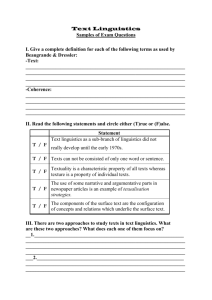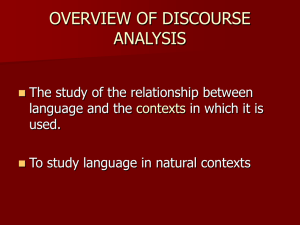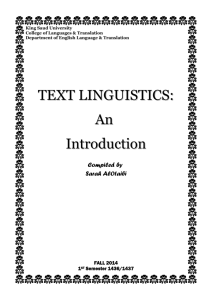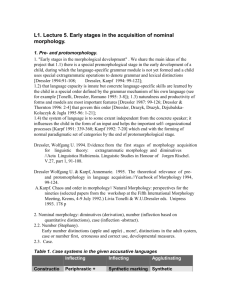Principles of Text-linguistics and Translation: Lecture 3
advertisement
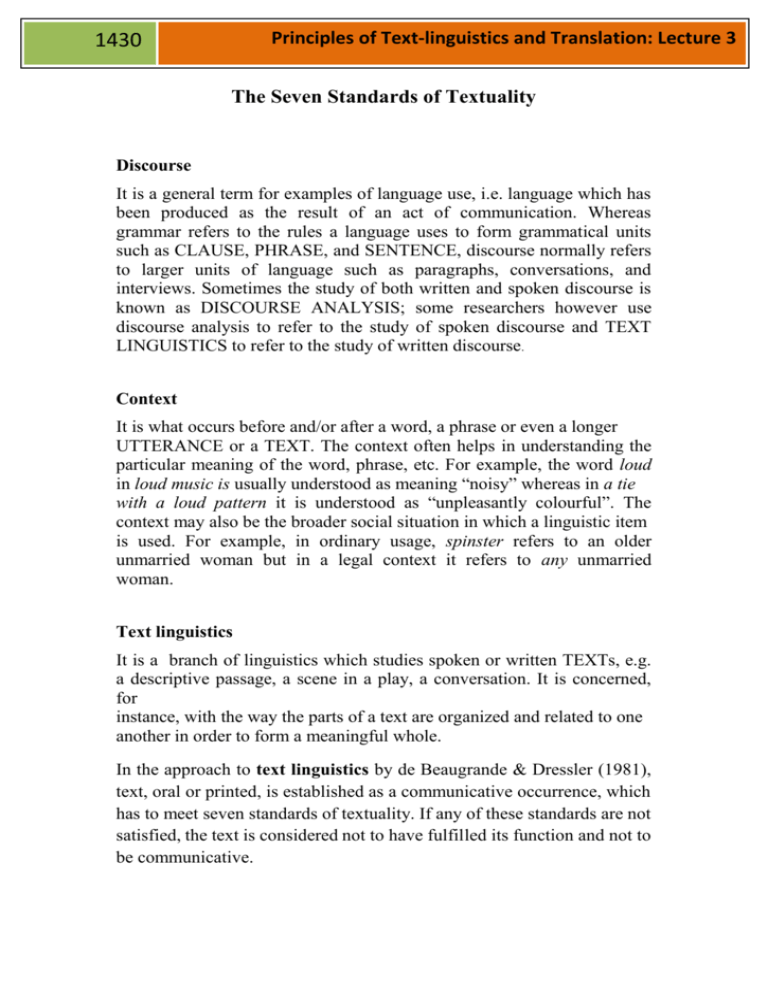
Principles of Text-linguistics and Translation: Lecture 3 1430 The Seven Standards of Textuality Discourse It is a general term for examples of language use, i.e. language which has been produced as the result of an act of communication. Whereas grammar refers to the rules a language uses to form grammatical units such as CLAUSE, PHRASE, and SENTENCE, discourse normally refers to larger units of language such as paragraphs, conversations, and interviews. Sometimes the study of both written and spoken discourse is known as DISCOURSE ANALYSIS; some researchers however use discourse analysis to refer to the study of spoken discourse and TEXT LINGUISTICS to refer to the study of written discourse. Context It is what occurs before and/or after a word, a phrase or even a longer UTTERANCE or a TEXT. The context often helps in understanding the particular meaning of the word, phrase, etc. For example, the word loud in loud music is usually understood as meaning “noisy” whereas in a tie with a loud pattern it is understood as “unpleasantly colourful”. The context may also be the broader social situation in which a linguistic item is used. For example, in ordinary usage, spinster refers to an older unmarried woman but in a legal context it refers to any unmarried woman. Text linguistics It is a branch of linguistics which studies spoken or written TEXTs, e.g. a descriptive passage, a scene in a play, a conversation. It is concerned, for instance, with the way the parts of a text are organized and related to one another in order to form a meaningful whole. In the approach to text linguistics by de Beaugrande & Dressler (1981), text, oral or printed, is established as a communicative occurrence, which has to meet seven standards of textuality. If any of these standards are not satisfied, the text is considered not to have fulfilled its function and not to be communicative. 1430 Principles of Text-linguistics and Translation: Lecture 3 Cohesion and coherence are text-centered notions, designating operations directed at the text materials. Cohesion concerns the ways in which the components of the surface text (the actual words we hear or see) are mutually connected within a sequence (de Beaugrande & Dressler 1981:3). Coherence on the other hand concerns the ways in which the components of the textual world, i.e. the concepts and relations which underlie the surface text are mutually accessible and relevant (1981:3-7). The remaining standards of textuality are user-centered, concerning the activity of textual communication by the producers and receivers of texts: Intentionality concerns the text producer's attitude that the set of occurrences should constitute a cohesive and coherent text instrumental in fulfilling the producer's intentions. Acceptability concerns the receiver's attitude that the set of occurrences should constitute a cohesive and coherent text having some use or relevance for the receiver. Informativity concerns the extent to which the occurrences of the text are expected vs. unexpected or known vs. unknown/uncertain. Situationality concerns the factors which make a text relevant to a situation of occurrence. Intertextuality concerns the factors which make the utilisation of one text dependent upon knowledge of one or more previously encountered texts. The above seven standards of textuality are called constitutive principles (cf. Searle 1965), in that they define and create textual communication as well as setting the rules for communicating. There are also at least three regulative principles that control textual communication: the efficiency of a text is contingent upon its being useful to the participants with a minimum of effort; its effectiveness depends upon whether it makes a strong impression and has a good potential for fulfilling an aim; and its appropriateness depends upon whether its own setting is in agreement with the seven standards of textuality (de Beaugrande & Dressler 1981:11).
